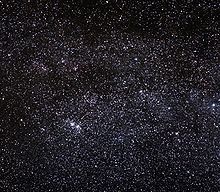- Double Cluster
-
Double Cluster 
Observation data (J2000.0 epoch) Constellation Perseus Right ascension 2h 20m Declination 57° 08′ Distance 7 kly (2300 Pc) Apparent magnitude (V) 4.3 Apparent dimensions (V) 60′ Physical characteristics Other designations h+χ Persei, Caldwell 14 See also: Open cluster, List of open clusters The Double Cluster (also known as Caldwell 14) is the common name for the naked-eye open clusters NGC 884 (χ Persei) and NGC 869 (h Persei), which are close together in the constellation Perseus. NGC 884 and NGC 869 are at distances of 7600 and 6800 light-years away, respectively, so they are also close to one another in space. The clusters' ages, based on their individual stars, are relatively young. NGC 869 is 5.6 million years old and NGC 884 is 3.2 million years old, according to the 2000 Sky Catalogue. In comparison, the Pleiades have an estimated age ranging from 75 million years to 150 million years. There are more than 300 blue-white super-giant stars in each of the clusters. The clusters are also blueshifted, with NGC 869 approaching Earth at a speed of 22 km/s (14 mi/s) and NGC 884 approaching at a similar speed of 21 km/s (13 mi/s). Their hottest main sequence stars are of spectral type B0.
Contents
Mythology
Perseus is the mythological symbol of adventure. Perseus was born the son of Zeus (The “Father of Gods and men” ) and the mortal Danae. He was a demigod but not immortal. Perseus was challenged by King Polydectes of Seriphos to slay one of the Gorgons (Medusa), whose gaze turned an on-looking victim into stone. Athena, Hermes, and other gods gave Perseus a helmet, a shield, and a curved sword with studded jewels on its handle to aid him in the challenge. Along with beheading Medusa, Perseus performed other heroic deeds as well, such as saving Andromeda who was a princess chained to a rock as a sacrifice to a sea monster. Due to his great accomplishments, the gods placed Perseus among the stars, with the head of Medusa in one hand and the jeweled sword in the other. The Double Cluster represents the jeweled handle of Perseus’s sword.[citation needed]
History
Hipparchus, a Greek astronomer, cataloged the object (a patch of light in Perseus) as early as 130 B.C. However, the true nature of the Double Cluster wasn’t discovered until the invention of the telescope many centuries later. In the early 19th century William Herschel, the German-born English astronomer, was the first to recognize the object as two separate clusters. The Double Cluster is not included in Messier's catalog, but is included in the Caldwell catalogue of popular deep-sky objects not in Messier.[citation needed]
Location
The Double Cluster is circumpolar (continuously above the horizon) from most northern temperate latitudes. It is in close proximity to the constellation Cassiopeia the Queen. The Double Cluster approximately marks the illuminated point of the Perseid meteor shower, which peaks annually around August 12 or 13. Although easy to locate in the northern sky, observing the Double Cluster in its two parts requires optical aid. They are described as being an "awe-inspiring" and "breathtaking" sight, and are often cited as a target in astronomy observer's guides.[1]
References
- ^ Chaple, Glenn (January 2011). "A double take". Astronomy.
External links
- SEDS page on the Double Cluster
- AstroPhoto.net page the Double Cluster
- Dark Atmospheres Photography - Perseus Double Cluster
- The Double Cluster - Astronomy Picture of the Day 2009 December 4
- DSLR Image of Double Cluster with Comet 103P/Hartley 2
- Double Cluster on WikiSky: DSS2, SDSS, GALEX, IRAS, Hydrogen α, X-Ray, Astrophoto, Sky Map, Articles and images
The Caldwell catalogue List C1 · C2 · C3 · C4 · C5 · C6 · C7 · C8 · C9 · C10 · C11 · C12 · C13 · C14 · C15 · C16 · C17 · C18 · C19 · C20 · C21 · C22 · C23 · C24 · C25 · C26 · C27 · C28 · C29 · C30 · C31 · C32 · C33 · C34 · C35 · C36 · C37 · C38 · C39 · C40 · C41 · C42 · C43 · C44 · C45 · C46 · C47 · C48 · C49 · C50 · C51 · C52 · C53 · C54 · C55 · C56 · C57 · C58 · C59 · C60 · C61 · C62 · C63 · C64 · C65 · C66 · C67 · C68 · C69 · C70 · C71 · C72 · C73 · C74 · C75 · C76 · C77 · C78 · C79 · C80 · C81 · C82 · C83 · C84 · C85 · C86 · C87 · C88 · C89 · C90 · C91 · C92 · C93 · C94 · C95 · C96 · C97 · C98 · C99 · C100 · C101 · C102 · C103 · C104 · C105 · C106 · C107 · C108 · C109See also  Book:Caldwell catalogue ·
Book:Caldwell catalogue ·  Category:Caldwell objects
Category:Caldwell objects  Portal:Astronomy ·
Portal:Astronomy ·  Commons:Caldwell objectsCategories:
Commons:Caldwell objectsCategories:- Open clusters
- Caldwell objects
- Astronomical asterisms
Wikimedia Foundation. 2010.

